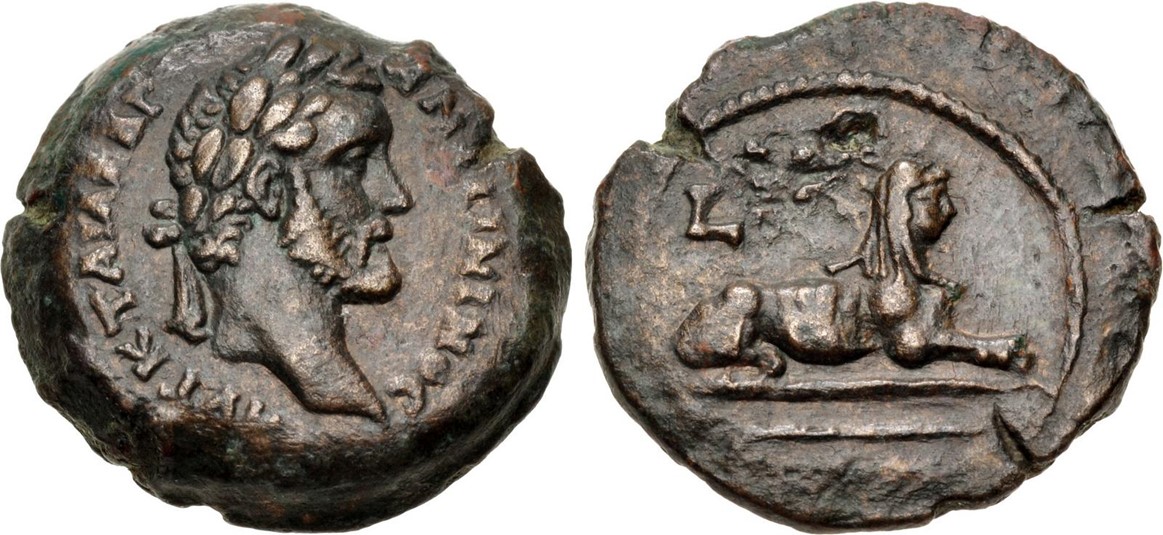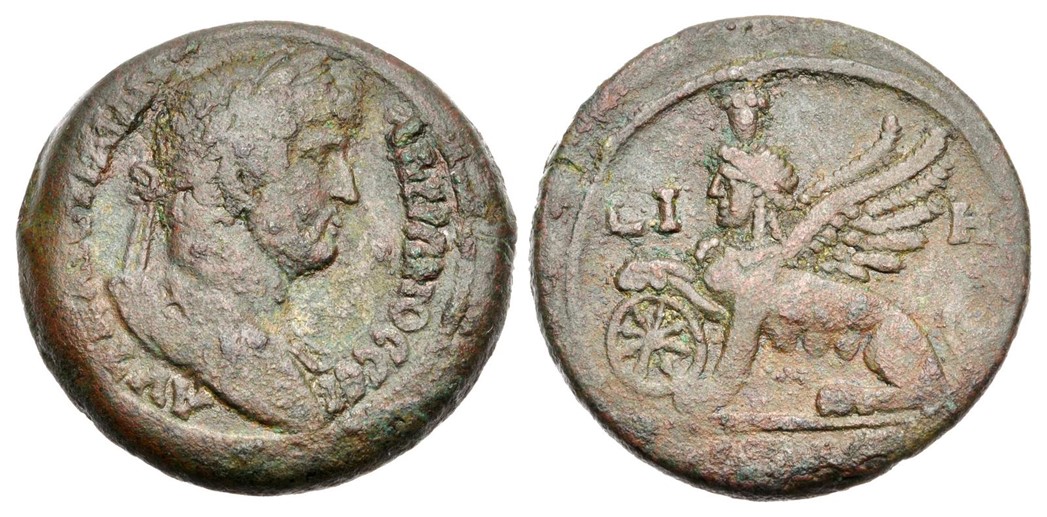NGC Ancients: Mythological Creatures, Part 2
Posted on 4/16/2024
The mythologies of ancient cultures contain a marvelous assortment of strange and often dangerous creatures, many of which blend human and animal characteristics. Some inspire feelings of wonder, while others invoke feelings of dread.
In a previous column (NGC Ancients: Mythological Creatures on Ancient Coins), we cataloged seven of these mythological beasts, and in this installment we continue our survey with a selection of equally fantastic creatures.
Sphinx
 |
We know creatures like these sparked the human imagination long before coins were first struck. A perfect example is the sphinx, which combines a head of a man with the body of a lion. The Great Sphinx of Giza, in Egypt, is believed to be over 4,500 years old — predating the advent of coinage by nearly two millennia.
The sphinx on this base metal obol struck in Egypt for the Roman Emperor Antoninus Pius (A.D. 138-161) looks very much like the familiar one at Giza.
 |
A sphinx is shown on the reverse of this electrum hecte from the Greek Island of Lesbos (just off the western coast of Turkey) dating to around 400 B.C.
 |
Another sphinx with wings is shown on this base metal drachm struck in Egypt under Roman Emperor Hadrian (A.D. 117-138).
 |
A double-bodied sphinx is portrayed on this electrum stater from Cyzicus, in northwest Turkey, dated to about 550-450 B.C.
Minotaur
 |
The Minotaur flips the script, with the head of a bull and the body of a man. Legend has it that the brilliant Daedalus built a labyrinth for King Minos of Crete to contain the savage beast. The Minotaur is shown on the obverse of this silver stater from Cnossus, Crete, struck ca. 425-360 B.C.
 |
This silver drachm of Cnossus from 300-270 B.C. also shows a labyrinth design on its reverse. In Greek mythology, Athens was required to periodically send people to King Minos so he could feed them to the Minotaur. The beast eventually was killed by the Athenian hero Theseus, who was among those sent as tribute.
Hydra
 |
Another legendary hero of ancient times, Hercules, was responsible for subduing several powerful beasts as part of his famous Twelve Labors. These included the Lernaean Hydra, a multi-headed serpentine monster who could grow additional heads each time one was cut off. This gold aureus from Roman Emperor Maximian (A.D. 286-305) shows Hercules battling the Hydra.
Hercules eventually found a way to defeat the Hydra; one account says he succeeded in severing and cauterizing all the other heads before severing the primary, immortal head; another version of the myth says he used the beast's own poison against it.
Cerberus
 |
The final task of Hercules was to capture Cerberus, the three-headed dog which guarded the gateway to the underworld. It is shown in a fierce posture opposite the goddess Demeter on this 16mm bronze coin struck ca. 338-335 B.C. at Elea in Epirus. (You can read previous columns about the Twelve Labors of Hercules on ancient coins here and here.)
 |
Cerberus also appears on an electrum stater issued ca. 450-330 B.C. at Cyzicus in Mysia, though this time it has only two heads!
Centaur
 |
A centaur is a creature with the body of a horse and the head of a person. One theory is that it was inspired by the reaction in an ancient culture to the previously unencountered sight of men riding horses. A centaur appears on this silver obol produced in around 500 B.C. by an uncertain Thraco-Macedonian tribe.
Satyr
 |
Another creature that combines horse and human features is the satyr, like the one shown on this silver trihemiobol struck c.412-404 B.C. on Thasos, an Island off Thrace. As companions of the raucous god Dionysus, satyrs often are depicted as having hair, ears and tails like horses and engaging in obscene behavior.
Hippocamp
 |
Mythical creatures weren't limited to land, as is shown on this silver shekel issued c.400-376 B.C. at Byblos in Phoenicia. In the foreground, swimming in front of a galley loaded with soldiers, is a hippocamp, which has the upper body of a horse and the lower body of a fish. The word hippocamp comes from the Greek words for horse and sea monster. Today, biologists use the name "hippocampus" for the scientific genus that includes seahorses.
Scylla and Charybdis
 |
Two sea monsters known by name were Scylla and Charybdis, who are depicted as menacing heads emerging from the base of a naval trophy on a silver denarius struck around 37-36 B.C for the Roman warlord Sextus Pompey. The monsters were believed to dwell off the coast of Sicily, which is where the Roman military leader was able to establish a short-lived independent state until he finally was defeated by the Second Triumvirate.
Capricorn
 |
The astrological sign Capricorn is based on an ancient mythical sea goat creature. A capricorn is shown on this silver cistophorus of Augustus, who ruled as Rome’s first emperor from 27 B.C. to A.D. 14.
Sirens
 |
Strange birds also have a place in mythology. Among them were sirens, which have the head of a woman but the body of a bird. A siren is depicted on this electrum hecte of Phocaea, in Ionia, struck ca. 477-388 B.C. They make an appearance in the Odyssey, attempting to use their beautiful voices to lure Odysseus' crew to their deaths.
 |
Depictions of creatures can evolve over time. Struck centuries later, this silver denarius of Emperor Augustus shows a siren whose body is much more human in appearance.
Phoenix
 |
Another famous mythological bird is the phoenix, renowned for its ability to regenerate after death (‘rising from the ashes’). A phoenix is shown on this billon tetradrachm struck in Egypt for Roman Emperor Antoninus Pius.
 |
A phoenix also appears on this billon half centenionalis of the Roman emperor Constans, a Christian who ruled from A.D. 337 to 350. The phoenix's purported power of resurrection apparently resonated with certain early Christians, and the phoenix and other creatures of ancient mythology continue to fascinate people to the present day.
Images courtesy of Classical Numismatic Group and Heritage Auctions.
Related Link: More NGC Ancients columns
Stay Informed
Want news like this delivered to your inbox once a month? Subscribe to the free NGC eNewsletter today!
